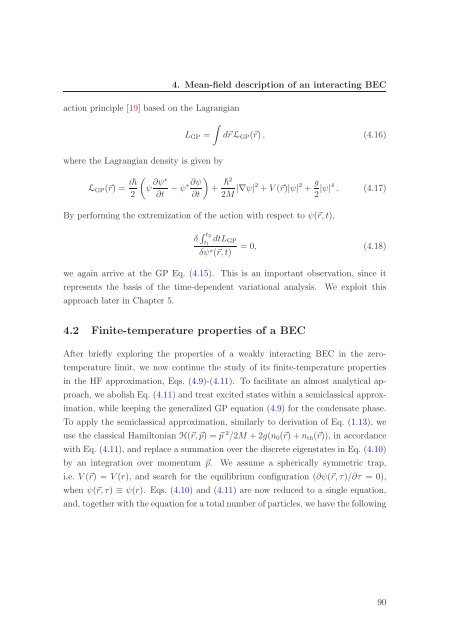PhD thesis in English
PhD thesis in English
PhD thesis in English
Create successful ePaper yourself
Turn your PDF publications into a flip-book with our unique Google optimized e-Paper software.
4. Mean-field description of an <strong>in</strong>teract<strong>in</strong>g BECaction pr<strong>in</strong>ciple [19] based on the Lagrangian∫L GP = d⃗r L GP (⃗r) , (4.16)where the Lagrangian density is given byL GP (⃗r) = i 2) (ψ ∂ψ∗∂t − ψ∗∂ψ + 2∂t 2M |∇ψ|2 + V (⃗r)|ψ| 2 + g 2 |ψ|4 . (4.17)By perform<strong>in</strong>g the extremization of the action with respect to ψ(⃗r, t),δ ∫ t 2t 1dtL GPδψ ∗ (⃗r, t)= 0, (4.18)we aga<strong>in</strong> arrive at the GP Eq. (4.15). This is an important observation, s<strong>in</strong>ce itrepresents the basis of the time-dependent variational analysis. We exploit thisapproach later <strong>in</strong> Chapter 5.4.2 F<strong>in</strong>ite-temperature properties of a BECAfter briefly explor<strong>in</strong>g the properties of a weakly <strong>in</strong>teract<strong>in</strong>g BEC <strong>in</strong> the zerotemperaturelimit, we now cont<strong>in</strong>ue the study of its f<strong>in</strong>ite-temperature properties<strong>in</strong> the HF approximation, Eqs. (4.9)-(4.11). To facilitate an almost analytical approach,we abolish Eq. (4.11) and treat excited states with<strong>in</strong> a semiclassical approximation,while keep<strong>in</strong>g the generalized GP equation (4.9) for the condensate phase.To apply the semiclassical approximation, similarly to derivation of Eq. (1.13), weuse the classical Hamiltonian H(⃗r, ⃗p) = ⃗p 2 /2M + 2g(n 0 (⃗r) + n th (⃗r)), <strong>in</strong> accordancewith Eq. (4.11), and replace a summation over the discrete eigenstates <strong>in</strong> Eq. (4.10)by an <strong>in</strong>tegration over momentum ⃗p. We assume a spherically symmetric trap,i.e. V (⃗r) = V (r), and search for the equilibrium configuration (∂ψ(⃗r, τ)/∂τ = 0),when ψ(⃗r, τ) ≡ ψ(r). Eqs. (4.10) and (4.11) are now reduced to a s<strong>in</strong>gle equation,and, together with the equation for a total number of particles, we have the follow<strong>in</strong>g90
















